How Do Cardinals Use the Same Nest Twice?
Cardinals don't recycle nests as doing so raises risks from parasites and predators. Females construct new nests each season between March and September using twigs, grass, and leaves.
This approach enhances breeding success by reducing threats. Male cardinals protect the territory and assist in feeding chicks after they hatch.
Each nesting location is meticulously selected to avoid harsh weather and predator presence, often in dense shrubs or thickets. By building new nests, cardinals guarantee improved protection and increased survival rates for their young.
Explore further to uncover how these behaviors influence cardinal populations and their survival strategies.
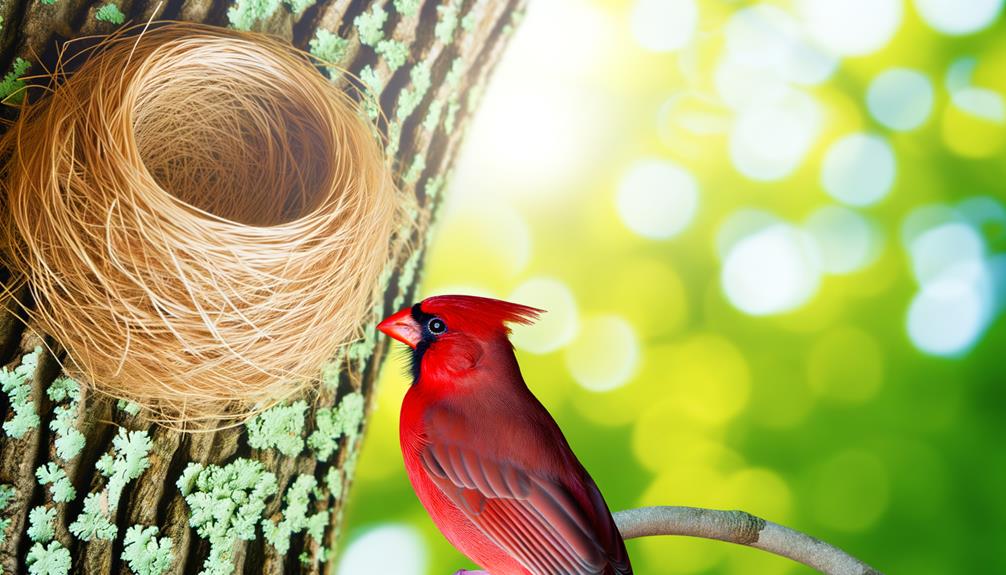
Key Takeaways
- Cardinals do not reuse the same nest to avoid parasites.
- Old nests deteriorate, reducing structural support and protection.
- Fresh locations minimize risks from predators familiar with previous sites.
- Building new nests each season enhances reproductive success.
- Avoiding old nests helps reduce the risk of mold and harmful conditions.
Cardinal Nesting Habits
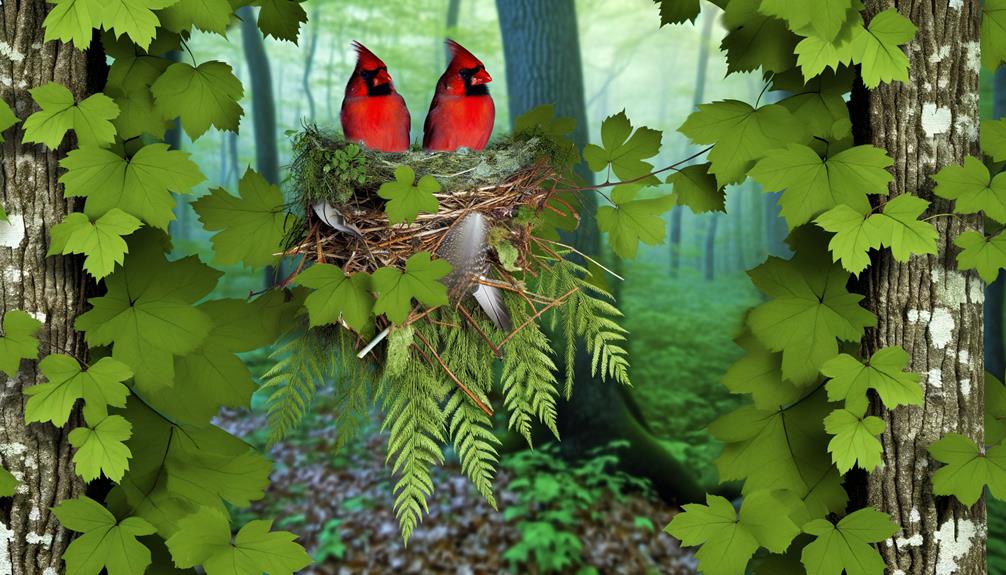
Cardinals, scientifically known as *Cardinalis cardinalis*, exhibit distinct nesting habits that are essential for their reproductive success.
You'll notice that cardinals prefer dense shrubbery or thick foliage to provide sufficient cover and protection from predators. They typically choose sites that are between 3 to 10 feet off the ground, ensuring a balance between accessibility and safety.
Cardinals are highly territorial during the breeding season, actively defending their chosen nesting area. They also demonstrate a unique behavior where the male assists in feeding the female while she incubates the eggs. This cooperation boosts the odds of successful hatching.
Understanding these nesting habits gives you insight into their survival strategies, emphasizing the importance of habitat preservation for these vibrant birds.
Nest Construction Process
You'll find that cardinals use a variety of materials and techniques when constructing their nests, often selecting twigs, grass, and leaves.
They show specific location preferences, typically choosing dense shrubs or trees to guarantee protection.
Seasonal variations in nest construction are evident, as they adapt their methods based on the availability of materials and environmental conditions.
Materials and Techniques
In constructing their nests, Northern Cardinals employ an intricate process that involves carefully selecting and weaving together twigs, leaves, and grasses. They use a variety of materials to guarantee the nest's durability and comfort. The nest-building technique is methodical and precise, contributing to the nest's strength and stability.
- Twigs: Form the outer structure, providing a sturdy framework.
- Leaves: Serve as insulation, helping to maintain the nest's internal temperature.
- Grasses: Woven into the interior for a soft, comfortable lining.
Cardinals meticulously intertwine these components, creating a secure environment for their eggs.
You'll notice their nests are both practical and resilient, showcasing a balance between strength and comfort. This detailed craftsmanship is crucial for the survival of their young.
Location Preferences
When selecting a spot for their nests, Northern Cardinals show a preference for thick greenery that provides both cover and security. You'll discover their nests in bushy regions, often positioned around 3-10 feet above the ground. They lean towards spots with dense vines, prickly shrubs, or lush trees. Cardinals give priority to locations that reduce the risk of predators and offer protection from severe weather.
| Location Type | Height Range (Feet) | Key Features |
|---|---|---|
| Bushy Areas | 3-10 | Thick foliage, thorny shielding |
| Vines and Thickets | 3-8 | Cover, intertwined branches |
| Short Trees | 5-10 | Dense cover, numerous branches |
Understanding these preferences helps you acknowledge the thorough selection process cardinals go through to guarantee the safety and success of their offspring.
Seasonal Variations
Cardinals display distinct seasonal variations in their nest construction process, adjusting their techniques and materials based on the time of year. In early spring, they use fresh branches and foliage, promoting better blending in and insulation.
As summer progresses, you'll notice them incorporating more durable materials like tree bark and grasses to withstand the heat and occasional storms.
These seasonal adaptations ensure ideal nest conditions for raising their young.
You'll find that cardinals are meticulous in selecting materials that suit the environmental demands of each season, demonstrating an impressive ability to adjust their behavior for survival and reproductive success.
Role of Male Cardinals
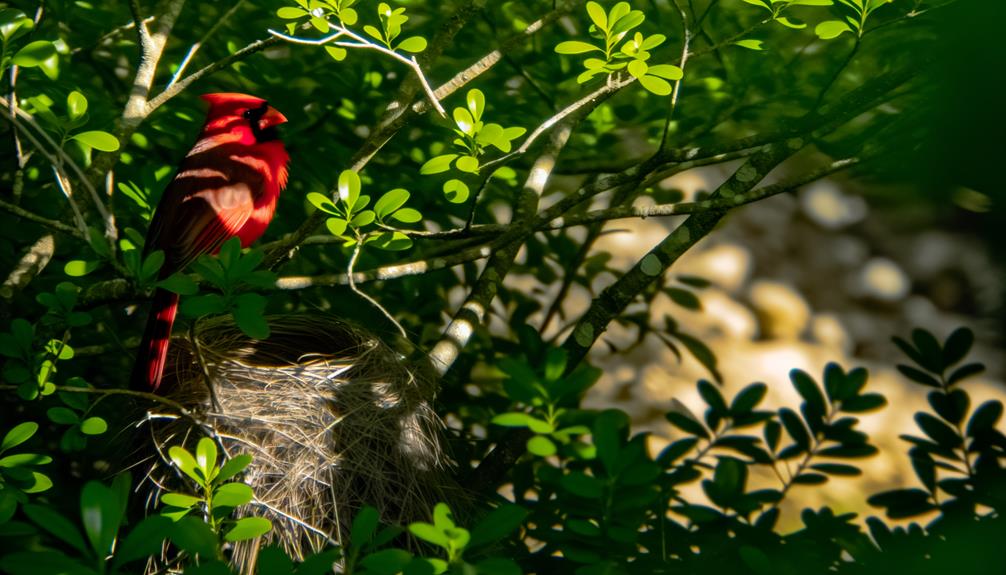
The male cardinal plays an important role in nesting by defending the territory, feeding the female during incubation, and assisting in feeding the chicks after they hatch.
You'll observe him staunchly guarding the nest area, using his vibrant plumage and distinctive song to ward off potential threats.
During the incubation period, he diligently provides food for the female, ensuring she remains nourished and can focus on keeping the eggs warm.
Once the chicks hatch, he continues his supportive role by helping to feed them, bringing a variety of insects and seeds.
This division of labor maximizes the chances of survival for the offspring, showcasing a well-coordinated effort between the cardinal pair in their nesting responsibilities.
Role of Female Cardinals
Female cardinals display remarkable dedication by carefully constructing the nest and incubating the eggs. You'll see that they choose secluded, well-hidden locations to minimize predator threats. Their nest-building process involves weaving together twigs, leaves, and grasses, creating a secure environment for their offspring.
- Nest Construction: Female cardinals are the primary builders, often completing the nest in just three to nine days.
- Incubation: They incubate the eggs alone for about 11 to 13 days, ensuring best temperature and protection.
- Feeding: Once the chicks hatch, the female mainly handles feeding, providing protein-rich food.
These diligent efforts by female cardinals are essential for the survival and growth of their young, demonstrating a strong commitment to their reproductive success.
Seasonal Nesting Patterns
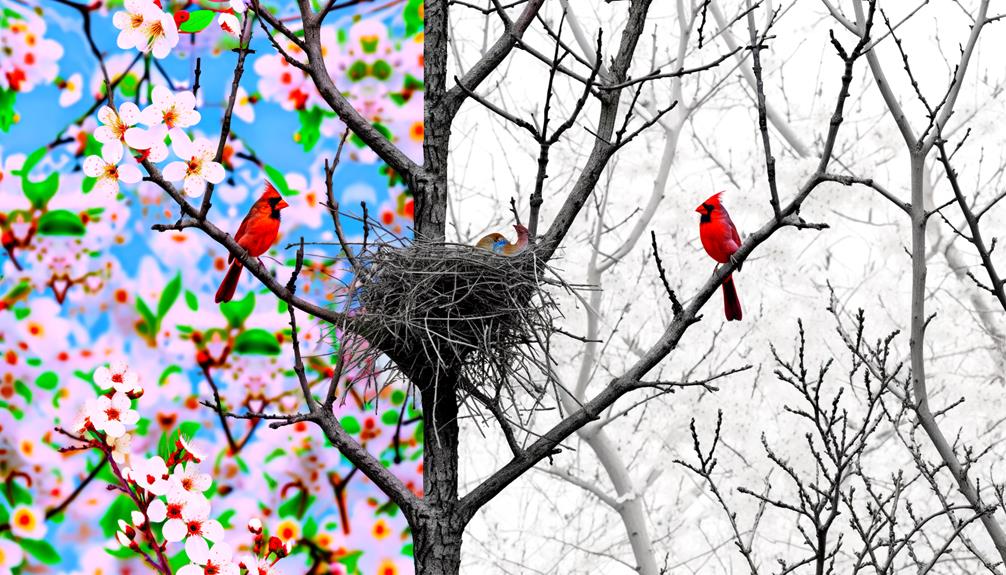
You should consider that cardinals typically nest between March and September, aligning their nesting timeframes with warmer weather and abundant food sources.
They don't usually reuse nests, preferring to build new ones each season to reduce parasite risk.
Observing their seasonal nest preferences can help you understand their reproductive strategies and habitat requirements.
Nesting Timeframes
During the breeding season, cardinals typically begin nest building in late March and may continue through late August. You'll find that these birds follow a systematic timeline:
- Early Spring: Nest construction and first brooding.
- Mid-Summer: Additional broods and frequent nest building.
- Late Summer: Final broods before the season ends.
Cardinals often raise multiple broods within a single season, usually two to three. Each breeding cycle involves meticulous nest building, incubation, and raising of the young. This pattern safeguards the survival and growth of their population. By observing these timeframes, you can gain insights into their reproductive strategies and overall behavior, highlighting the adaptability and resilience of cardinals in their natural habitats.
Seasonal Nest Preferences
Cardinals exhibit distinct seasonal nesting preferences, often selecting dense shrubs and low tree branches for best concealment and protection throughout their breeding period. You'll find that during spring, they favor thicker foliage to safeguard their young from predators. In summer, they might choose areas with abundant shade to keep nests cool, while in early autumn, they shift slightly higher to avoid ground-level threats.
Here's a quick look at their preferences:
| Season | Preferred Nest Location | Key Consideration |
|---|---|---|
| Spring | Dense Shrubs | Predator Protection |
| Summer | Shaded Areas | Temperature Regulation |
| Autumn | Higher Branches | Avoid Ground-Level Threats |
Understanding these patterns helps you appreciate their adaptability and survival strategies through changing seasons.
Environmental Factors
Although many factors influence whether cardinals reuse a nest, environmental conditions such as temperature, humidity, and predator presence play a crucial role. You'll find that these factors profoundly affect nest selection and reuse. Specifically, cardinals are sensitive to:
- Temperature: Extreme heat or cold can make a nest unsuitable for future use.
- Humidity: High moisture levels can lead to mold growth, which is harmful to both eggs and chicks.
- Predator presence: Frequent visits by predators make a nest location unsafe.
Predation and Nest Safety

When considering predation and nest safety, you need to understand how the risk of predators influences a cardinal's decision to reuse a nest.
Cardinals often choose new locations to minimize the chances of predators finding their nests. By relocating, they enhance the survival rate of their offspring.
Risk of Predators
Why do cardinals often abandon their nests after a single use?
The primary reason is the risk of predators. Cardinals prioritize nest safety to guarantee the survival of their offspring.
Reusing a nest can increase the likelihood of predation because:
- Predator Familiarity: Predators can recall nest locations, making reused nests more vulnerable.
- Scent Accumulation: Repeated use of a nest can leave behind odors that attract predators.
- Structural Wear: Nests degrade over time, making them less secure and easier for predators to access.
Nest Location Choice
Cardinals meticulously select nest locations to minimize predation risks and ensure the safety of their young. You'll notice cardinals prefer dense shrubs and thickets, providing excellent cover from predators. They often avoid exposed areas to decrease the likelihood of discovery by predators like snakes, raccoons, and hawks. By choosing concealed sites, cardinals enhance the survival chances of their offspring.
Additionally, cardinals tend to build nests at intermediate heights, neither too low nor too high, balancing accessibility and safety. You'll find they often select spots where foliage provides natural camouflage. This strategic placement not only deters predators but also shields the nest from harsh weather conditions.
Therefore, cardinals' careful nest location choices are pivotal in ensuring the protection and success of their young.
Re-use of Old Nests
Observations indicate that Northern Cardinals rarely reuse their old nests for subsequent broods. When they build new nests, it's often due to several scientific reasons:
- Parasite Avoidance: Old nests can harbor parasites that may harm the new brood.
- Structural Integrity: Over time, nests deteriorate and may not provide the necessary support and protection.
- Predator Awareness: Using a fresh location helps minimize the risk from predators familiar with the old nest site.
These behaviors guarantee the safety and health of their offspring. By constructing new nests, cardinals increase their chances of successful breeding.
You'll find that their decision to not reuse nests is a strategic adaptation that supports their survival in the wild.
Comparative Bird Behavior

Understanding these nesting behaviors in Northern Cardinals can be enriched by comparing them with the nesting habits of other bird species.
For example, unlike cardinals, many raptors, such as bald eagles, reuse their nests for several years, often adding new materials each season.
On the other hand, hummingbirds construct new nests for each brood, similar to cardinals.
Woodpeckers excavate new cavities annually, displaying a preference for fresh nesting sites.
By examining these contrasting behaviors, you can appreciate the ecological and evolutionary factors influencing nest reuse.
Each species' approach is adapted to its unique environmental pressures and reproductive strategies, highlighting the diversity of avian nesting habits and the complexity of their survival mechanisms.
Observations by Ornithologists
Many ornithologists have meticulously documented the nesting habits of Northern Cardinals, noting that these birds rarely reuse their nests.
You'll find that cardinals exhibit specific behaviors when it comes to nest building and usage. Researchers have observed:
- Cardinals often select new nesting sites for each breeding cycle.
- The birds frequently build nests in dense shrubbery or thickets to protect from predators.
- They tend to abandon nests after fledglings leave, likely to reduce parasite load.
These observations suggest that cardinals prioritize creating fresh, secure environments for their young.
By constantly choosing new locations, they can avoid potential threats and guarantee the highest chances of offspring survival.
This behavior is a fascinating adaptation to the challenges of their natural habitat.
Impact on Cardinal Population
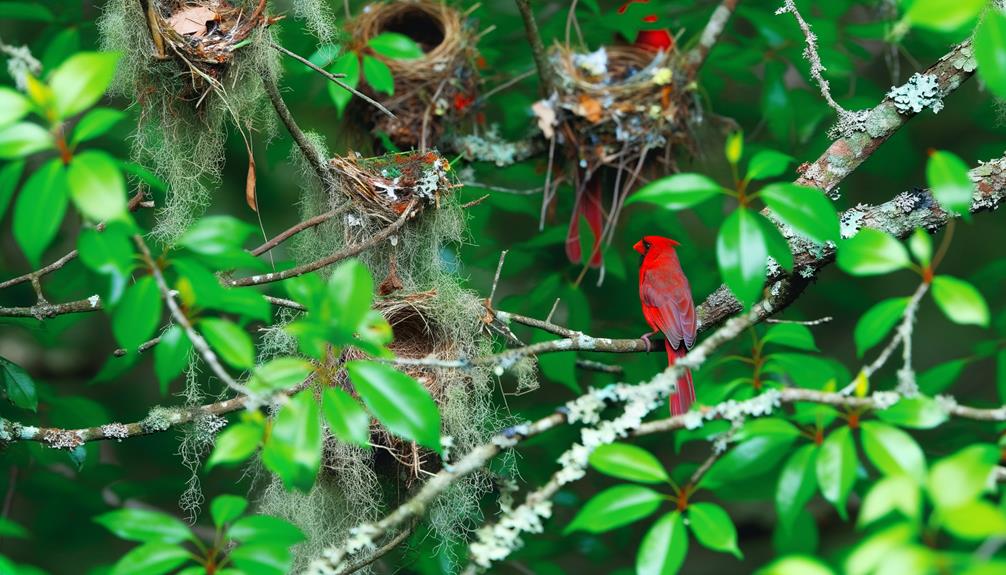
The cardinal's practice of building new nests for each breeding cycle plays a crucial role in maintaining healthy population levels by minimizing the risk of predation and parasite infestations. When cardinals construct fresh nests, they avoid the buildup of harmful parasites like mites and lice, which can greatly impact chick survival rates.
Additionally, the varied nest locations deter predators from targeting successive broods in a single season. This adaptive behavior ensures that each new generation has a higher chance of reaching maturity. By constantly relocating their nesting sites, cardinals enhance their reproductive success and contribute to the overall stability of their population.
Understanding these behaviors can help you appreciate the intricate strategies birds employ to thrive in their natural environments.
Encouraging Nesting in Your Yard
Creating an inviting habitat in your yard can greatly boost the likelihood of attracting cardinals to nest. To promote these vibrant birds, focus on providing essential resources.
First, ensure there's abundant cover with thick shrubs or petite trees, as cardinals prefer secluded nesting sites.
Second, offer a steady food supply, such as sunflower seeds and safflower seeds, which are cardinal favorites.
- Thick shrubs or petite trees: Provide privacy and protection for nesting.
- Steady food supply: Use feeders with sunflower and safflower seeds.
- Water sources: Birdbaths or shallow water dishes.
Conclusion
By observing cardinals, you'll understand their unique nesting habits. You'll see males scouting locations, females weaving intricate nests, and both parents nurturing their young.
You'll notice their inclination for fresh sites each season, unlike some birds that reuse nests. Ornithologists' studies reveal how these behaviors impact cardinal populations.
To attract cardinals to your yard, provide dense shrubs, offer food, and guarantee a water source. This comprehensive approach enriches your understanding and supports their natural life cycle.





